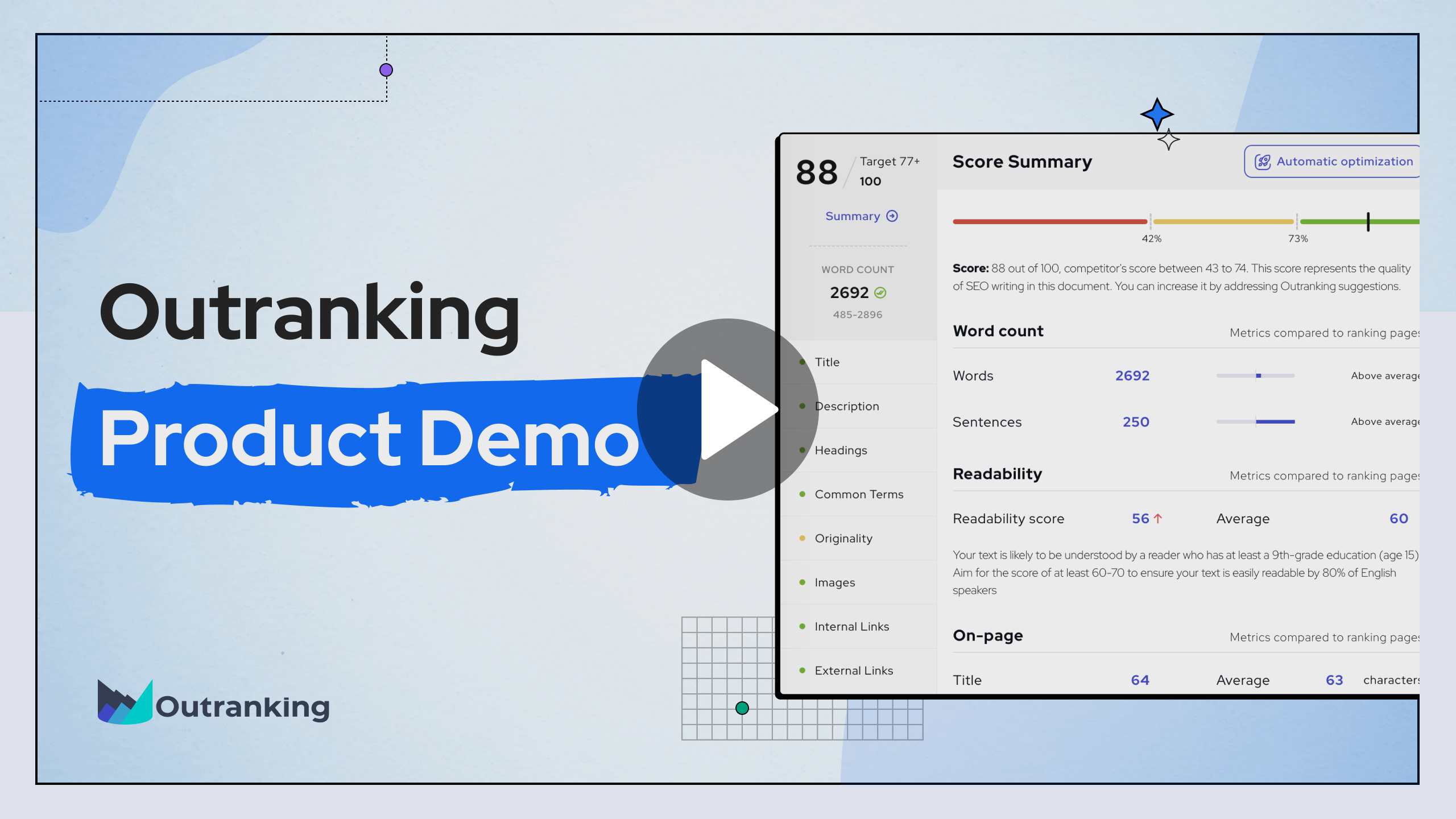- Product
- SEO Content Editor
- SEO Content Strategy
- Content Optimization
- Content Briefs
- AI Assisted Writing
- Keywords Clustering
Preview a demo walkthrough
Outranking the competition with our cutting-edge SEO strategies.

- Pricing
- Resources
- Sign In
- Get Started

How Is the Definition of Quality SEO Content Changing
Table of Contents
If you have any kind of content strategy in place, whether you’re optimizing for search engines or just trying to add more value to your readers, you know the importance of writing quality content. Good content can help you engage with readers, boost your website’s visibility, and increase your marketing momentum for years to come.
But wait.
You’re probably writing content for both search engines and online users. We know that search engines have evolved considerably over the years and are on a trajectory to change even more in the future. We also know that consumer preferences are almost constantly changing.
So doesn’t it stand to reason that our definitions of “quality content” need to change as well?
In this article, we’re going to look at what it takes to make “quality content,” and how the standards for content quality have changed over the years – as well as where we’re going from here.
Table of Contents
The Importance of Quality Content
Why is it that quality content is so important to your SEO content strategy in the first place?
- Domain authority
It’s no secret that quality content is essential if you want to optimize your website for search engines. Google and other search engines have tools they can use to evaluate the quality of your content; if it doesn’t meet expectations, it could hurt your domain authority, in turn lowering your ranking potential. If it exceeds expectations, it could help you rank immediately.
- Inbound links
Additionally, good content tends to attract a lot of links. As you likely know, the more links you attract to your site, and the more authoritative those links are, the higher your domain authority will climb and the higher you’ll be likely to rank for relevant keyword terms. In other words, the more quality content you write, the more links you’ll get – ultimately leading to higher rankings, more brand visibility, and more traffic.
- Onsite user behavior
Content quality has an enormous impact on onsite user behavior as well. If your content is sufficiently engaging and useful, you’re going to have a lower bounce rate, your users will stick around to read even more of your content, and you’ll achieve more conversions as well. Obviously, this is directly beneficial to your brand, since interested and engaged users will generate revenue on your behalf. It’s also important for search engines, however; the average bounce rate is between 41 and 51 percent, but the lower your bounce rate is, the higher your likelihood of ranking highly in search engines will be.
- Brand reputation
Content has an impact on your brand reputation as well, for better or for worse. If you’re known for generating well-written, thoughtful content, people will be more trusting of your brand and start to think of you as more of an authority. If your content is unsatisfactory, even great products and services may not be able to save your reputation.
As you can see, quality content is important for both search engines and users directly. Search engines will be evaluating your content quality to rank you accordingly. Users will be forming judgments of your brand based on your content strategy.
Both need to be happy if you’re going to succeed. And both have ever-shifting standards.
Subjective vs. Objective Metrics for Quality Content
If you ask 25 different marketing experts what it means to have “quality content,” you’re probably going to get 25 different answers. And that’s not even a hypothetical.
The truth is, there will always be some differences between subjective and objective metrics to be used for content analysis.
On some level, we can strive to objectively calculate whether a piece of content is quality content. If it doesn’t have any technical errors, if it loads quickly and fully, and it contains more than a few hundred words – you’re off to a good start.
There are a few problems with conducting an objective content analysis, however, as you’ve undoubtedly experienced in your own content strategy:
- Google’s algorithm is cryptic and opaque
First and foremost, while Google is open about publishing their guidelines for building and managing websites, they’re more opaque about their search algorithm. We don’t have direct insight into the mechanical efforts undertaken to analyze content – and there are hard limits to how much knowledge we can acquire through independent studies alone.
- Objective standards for quality content can change
As we’ll explore shortly, objective metrics for what qualifies as quality content can change. For example, the ideal length for a blog post in an SEO context has changed considerably.
- Subjective qualities matter too
Most search optimizers I know (and marketers in general) attempt to reduce everything to objectively measurable statistics. However, this isn’t always possible, especially when it comes to quality content. For example, we may all agree that users appreciate “concise” content, but what’s your definition of “concise?” What counts as concise for one reader may register as overly detailed for another.
We’ll be considering both objective and subjective qualities as much as possible in our analysis of how quality content definitions have changed.
A High-Level Breakdown of Quality Content in Your Content Strategy
To provide the most concise definition of “quality content” possible, we can define this as any content that achieves a specific goal, pleases a target audience, and enables you to achieve the best possible results when evaluated by Google. This usually requires attention to a variety of factors, including subject matter, length, formatting, and publishing/distribution.
A History of Quality Content in the Eyes of Google
When Google first launched, its primary goal was connecting web users to relevant, authoritative content. With such sparse content on the web and technological limitations, it was restricted in its ability to effectively evaluate content quality.
Over the years, a series of updates, including the infamous Panda update of 2011, expanded Google’s content quality evaluation capabilities and in some ways changed the definition of quality content. Still, at its core, Google’s main objective is simply connecting users to the content that’s going to serve their needs best. In this way, users still dictate what’s considered “quality content.”
Changing Reader Perspectives on Quality Content
While Google sometimes makes choices based on what it thinks will be good for the health of the web ecosystem, reader preferences are naturally emergent from the ground up. Most users don’t go through the conscious scrutiny of evaluating content; they simply like what they’re reading or they don’t. And over time, different qualities have forced readers to relegate content to one category or the other.
Better technology, like mobile devices, can change how readers interact with content. New mediums, like short-form social media posts, can change their expectations for consuming information. Cultural trends, like an increased emphasis on texting and emojis in conversation, can change how they read and process things.
Changing reader preferences aren’t a straight line pushing for higher and higher quality; instead, they tend to ebb and flow with technological and cultural changes.
Timeless Qualities of “Good” Content
There are some timeless qualities of good, quality content – aspects of content that have always been important and will likely be important for the indefinite future.
Since the dawn of the information age and for many years to come, you should prepare content with the following qualities:
- Relevance
As content creators, we’ve always needed to consider the relevance of the work we’re creating. We need to cover topics that are specifically important to our target audience. That often means addressing common questions, covering news and current events, and doing deep analytical dives on important topics. This has always been a staple of quality content, and likely always will be.
- Originality
If someone else has already written extensively on a specific topic, why should you spend your time mirroring them? Your work also needs to be original, in at least some way. If a topic has already been covered, you can try to find a unique angle on it, present it to a new audience, or present it in a different way.
- Clarity
Clarity is somewhat subjective, but users know it when they encounter it. If your work is clear, it’s going to be well-written, easy to understand, and unambiguous. This is where the skill of the writer really becomes clear.
- Accessibility
Quality content is accessible. If it doesn’t load quickly, if it doesn’t load fully, or if it’s hard to read for other reasons (such as having yellow text on a white background), it’s not going to go over well with your readers.
- Grammatical and semantic sensibility
Your work, if written, should be grammatically and semantically close to perfect. Spelling, punctuation, and other technical issues need to be addressed before publication. This has always been a considering factor for both search engines and users, but it’s actually grown in importance over the years.
- Detail and support
Quality content contains sufficient detail and support, featuring statistics, logical reasoning, and plenty of outbound links to authoritative sources. It remains debatable whether outbound links affect SEO directly, but there’s no question that users will be paying attention to how much research you’ve done to support your work.
- Tone and personality
This is a largely subjective quality, but many readers will form an impression of your brand based on the tone and personality you present in your writing. These days, readers prefer a more conversational, informal tone – but tone and unique personalities have always been important in your writing.
- The entertainment factor
As far as I know, Google’s search algorithm doesn’t have any objective way to measure how “fun” your content is. But your users will know. While some types of content need to be formal and professional, most web content performs better when it offers some level of entertainment, with humor and levity.
- Keyword optimization
Any content strategy will have a list of target keywords to focus on with your content. Accordingly, quality content should include these keywords in some capacity – and that’s always been the case. However, the specific types of keywords and the proper way to include them have evolved considerably in the past couple of decades.
The Evolution of Quality Content
However, there are also some qualities that have changed in some way since the dawn of the modern content marketing era – and they may change substantially in the future as well.
- Length
In the early days of SEO, as long as a page of your website had at least 250 words of content, it was considered suitable for SEO. These days, longer-length posts are preferred. According to Yoast SEO, a “cornerstone” content page needs to have a minimum of 900 words to even be considered. According to some studies, there’s a clear correlation between content length and search engine ranking; if your content is several thousand words or more than 10,000 words, you’ll stand a much higher chance of ranking when compared to even a 2,000-word post. Of course, there’s also room for shorter pieces of content to rank, but generally speaking, time has favored longer pieces of content.
- Formatting
We also need to think about formatting. In the early days of SEO, formatting was merely a secondary consideration. Google evaluated the text on your page quite literally and users didn’t have established preferences. These days, you’ll get higher engagement rates, lower bounce rates, and better value overall if your post is broken up into relatively short sections and sentences. Quick, punchy sentences are easier on the eyes (and better for mobile devices), and proper formatting with SEO H1 tags and (in some cases) micro formatting can help you rank better.
- Multimedia presence
Increasingly, web users want to see content with multimedia additions. They want infographics, photos, videos, and even audio to flesh out the vision of your article. And since 20 percent of all searches on the web are for images, optimizing images in your content can have secondary benefits – and greatly expand the territory you can conquer in search engine results pages (SERPs).
- Value for time
Google has trouble evaluating the subjective qualities of the content you produce – but web users don’t struggle at all. Today’s web users have limited attention spans. They’re incredibly busy. They have questions and want quick answers. Accordingly, they want to feel like reading your content gives them good value for the time they spend. If it’s several thousand words long and it does a deep dive into a topic, it needs to be thorough and worth every minute they spend reading it. If it’s short, it should provide immediate answers to the questions that brought users in.
- Shareability
Social media wasn’t even a consideration in the early days of SEO. Now it has a significant impact on content strategy. Note that social media factors like shares and likes don’t directly impact SEO; however, getting lots of shares and likes can increase your likelihood of earning links, which will impact SEO. Accordingly, modern search optimizers are more likely to focus on the “shareability” of a piece of content in addition to its other qualities. Shareability is a topic worthy of its own in-depth explanation – but suffice it to say, you’ll need to think about the digestibility, the power of your headline, the emotional influence of your topic, and other factors.
- Keyword style and prevalence
As I alluded to earlier, the demand for keywords and phrases in the body of your content has changed. Previously, you could get away with shoehorning in keywords wherever you wanted, practically spamming your users. These days, readers are acutely aware of these tactics, and they’ll leave your site if they feel they’re being manipulated – or that your content was written for a machine. Additionally, thanks to Google’s semantic search capabilities, exact match keywords aren’t as important as they used to be. Including semantically related phrases, synonyms, and rewordings can be even more valuable than stuffing inexact matches.
The Future of Quality Content
So how are the standards for quality content going to change in the future?
That’s hard to say. In 2011, we couldn’t have predicted that in 2021, users would demand shorter, punchier, more conversational content. In 2031, that trend may continue, pushing us to even more informal heights, or it may reverse, paving the way for more formal, professional content.
What we know for sure is that the standards for quality content are going to change somehow. If the history of Google’s algorithm changes is any indication, Google takes its ongoing evolution and development seriously, and we can expect it to refine its content quality standards further in the years to come. We’ll also see changing consumer preferences thanks to a combination of new technologies, emerging content trends, and aging demographics.
If you want to continue producing some of the best quality content on the web, it’s on you to understand the history of quality content guidelines and the present requirements for ranking highly in search engines. More than that, you have to remain aware and adaptable enough to keep changing your approach to content development. If you refuse to adapt, your “good” content may gradually come to be seen as weak, and your competitors will eventually overtake you.



